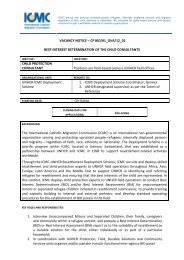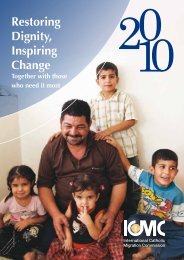ICMCEUROPE WelcometoEurope.pdf (5.89 MB)
ICMCEUROPE WelcometoEurope.pdf (5.89 MB)
ICMCEUROPE WelcometoEurope.pdf (5.89 MB)
Create successful ePaper yourself
Turn your PDF publications into a flip-book with our unique Google optimized e-Paper software.
290<br />
Chapter VII – Building a New Life in the Community<br />
often unwilling to receive resettled refugees<br />
because of a lack of available and<br />
affordable housing. Affordable housing<br />
is generally more readily available in<br />
smaller municipalities, which can be<br />
some distance from the main economic<br />
and cultural urban centres. For those<br />
with specific employment skills and/or<br />
who wish to access trainings and university<br />
education, placement in smaller<br />
or more remote areas can constitute a<br />
huge barrier for integration and their<br />
aspirations for their own resettlement.<br />
For those from specific religious or cultural<br />
backgrounds, living some distance<br />
away from relevant institutions and<br />
facilities can also be problematic. 16<br />
Despite these limitations, smaller communities<br />
can offer resettled refugees<br />
a ‘soft landing’ in the resettlement<br />
country in which both essential services<br />
and local communities and networks<br />
are more easily accessible. This<br />
can particularly benefit families with<br />
younger children, single-parent households<br />
and more vulnerable individuals<br />
or groups with limited experience of<br />
larger urban contexts.<br />
Outside of larger cities, affordable<br />
housing may be located in more isolated<br />
areas some distance from basic<br />
16 An evaluation of the 2008 local programme to<br />
resettle Rohingya refugees to Carlow County in<br />
Ireland, for example, found that the absence of a<br />
mosque and space for religious burials created huge<br />
barriers for their long-term integration, and were<br />
the main motivating factors for refugees considering<br />
leaving the area.<br />
services, creating challenges for service<br />
providers in delivering programmes<br />
accessible to all refugees. In the<br />
Swedish region of Gävleborg, municipalities<br />
have addressed this challenge<br />
through regional cooperation, such<br />
as holding joint Cultural Orientation<br />
sessions in one municipality to which<br />
refugees from around the region are<br />
transported, and jointly procuring<br />
interpreters for particular refugee<br />
groups.<br />
When deciding on placement, national<br />
authorities may also consider factors<br />
such as the presence of similar<br />
ethnic, national, religious or language<br />
groups, the presence of appropriate<br />
interpreters and the capacity of local<br />
services when making decisions on<br />
placement for resettled refugees.<br />
2.2. Planning reception &<br />
integration<br />
Resettlement is a planned activity, and<br />
information about resettled refugees is<br />
known prior to their arrival into a resettlement<br />
country. To be effective, local<br />
reception and integration programmes<br />
must receive information on the groups<br />
and profiles that will come to their<br />
community in an as full and accurate<br />
form as possible, and within timescales<br />
that make pre-arrival planning realistic.<br />
In Europe, timescales for the provision<br />
of information to local actors vary





